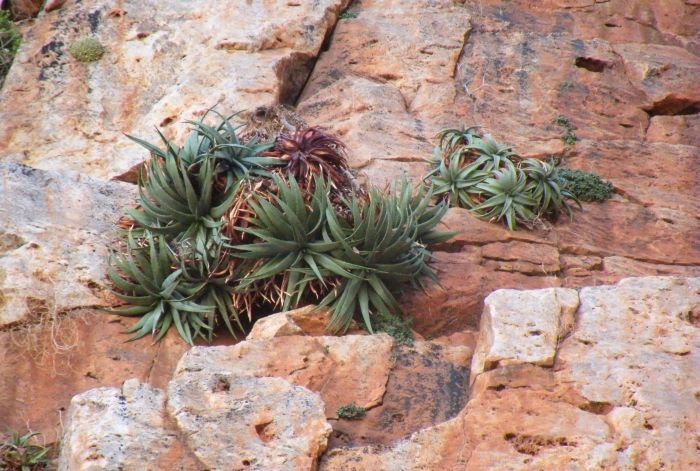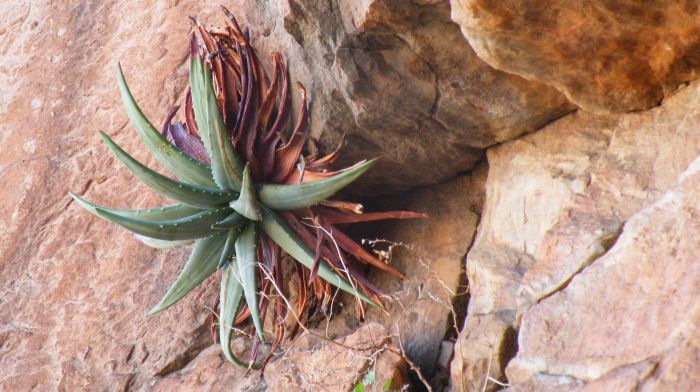Aloe dabenorisana
Aloe dabenorisana Van Jaarsv.
Family: Asphodelaceae
Common names: Dabenoris aloe, Pella aloe (Eng.); pella-aalwyn (Afr.)
Introduction
Aloe dabenorisana is a rare, medium-sized, cluster-forming, cliff-dwelling aloe, up to 300 mm high, with short, sometimes drooping stems and leaves in a rosette. The leaves recurve exposing the crown. The ascending, sparsely branched inflorescence bears conspicuous tubular, orange-red flowers arranged in pointed heads and is pollinated by sunbirds. It is only known from cliffs along the Groot Pellaberg and Dabenorisberg Mountains of the lower Orange River of the Northern Cape. Grows well in containers in a dry, frost-free environment.

Figure 1. A close-up of the rosette of Aloe dabenorisana in flower in cultivation. (Photo: Philip Nell)
Description
Description
Aloe dabenorisana is a slow-growing, long-lived, perennial (from seed 5–7 years), forming pendulous clusters (rarely solitary), branched from the base, with short, elongated stems up to 300 mm long. The roots are slightly fleshy. The leaves grow in an apical rosette up to 450 mm in diameter, narrowly lanceolate-acuminate, up to 240 mm long, 50 mm in diameter, recurved, sometimes deflexed. The leaf surface is green, becoming tinged with red during dry spells. The leaf margin is green to reddish, armed with small, deltoid teeth. The inflorescence is 2–4-branched, pendulous, recurved, up to 300 mm long; the racemes in pointed heads. The flowers are spreading, subpendent, the perianth is orange-red, green-tipped, 25 mm long. The fruiting capsule is ascending-spreading. Seed is brownish, winged. Flowering time is in midsummer (December to January southern hemisphere).

Figure 2. Two clusters of Aloe dabenorisana on the Dabenorisberg, N. Cape.
Conservation Status
Status
Although only known from 2 mountain ranges in the lower Orange River Valley, Aloe dabenorisana is not threatened, but is, however, classified as Rare. Plants are well protected by their sheer, inaccessible cliff-face habitat in a remote area, making them difficult to reach.

Figure 3. Habitat of Aloe dabenorisana on a south slope of Dabenorisberg.
Distribution and habitat
Distribution description
Aloe dabenorisana is confined to the Dabenoris and Pellaberg Mountains. It grows on south-facing, quartzitic, sandstone cliffs. The geology consists of light-coloured quartz of the Hom Formation (Bushmanland Group), with many ledges, fissures and crevices, ideal for establishment of plants. This gives rise to a slightly acidic, nutrient-poor, sandy soil. Aloe dabenorisana grows firmly rooted in crevices large enough to support the roots and stem clusters. The average daily maximum temperature is about 27ºC and about 12ºC in winter (in summer it can reach about 35–40ºC). The southern slopes are cooler and shady in the winter months and frost is absent. Rainfall occurs mainly from autumn (thunder showers) to spring and ranges from about 75–150 mm per annum. Plants grow at an altitude of about 700–1 000 m. The vegetation consists of Eastern Gariep Rocky Desert of the Desert Biome (Mucina et al. 2006). Associated cliff-dwelling plants in its habitat include Adromischus diabolicus, Conophytum fulleri and C. marginatum subsp. haramoepense, Crassula exilis subsp. sedifolia and C. garibina and Tylecodon sulphureus var. armianus.

Figure 4. Two clusters of Aloe dabenorisana on the Dabenorisberg, Bushmanland, N. Cape. Note the Conophytum sp. in the left hand corner and Tylecodon sulphureus var. armianus on the right hand side, both obligatory cliff-dwelling plants.
Derivation of name and historical aspects
History
Aloe dabenorisana was named by the author in the Journal of South African Botany in 1982 (Van Jaarsveld 1982). It was named after the Dabenoris Mountain (Bushmanland, Northern Cape) where the plants were discovered by Mr Anthony R. Mitchell, a British citizen presently residing on the Isle of Man. He is an intrepid explorer who explored Namaqualand and the southern Namib on his bicycle, primarily for his main interest, a small, cluster-forming button in the genus Conophytum, which he brought to the author’s attention, who, upon investigating the Dabenorisberg, found and described this species. He is also commemorated in Portulacaria armiana, Conophytum armianum and Othonna armiana, from his initials and plant collector’s acronym, ARM.
The name Dabenoris is of Khoekhoen origin and, according to Nienaber & Raper (1983), means ‘narrow gorge where the tamarisk trees grow’. Tamarisk usneoides is indeed very common in dry river beds in the Dabenorisberg.
Aloe dabenorisana belongs to a group of 7 aloes belonging to Prolongatae series Mitriformis (Reynolds 1950) of which A. mitriformis (Aloe perfoliata), is the most widespread and well known. These aloes are mostly confined to regions with winter rainfall, characterised by their usually elongating stems, persistent leaves and pointed, often branched, racemes in dense heads and with striking orange-red, tubular flowers when in full flower. Aloe mitriformis grows along the Cape Folded Mountains and as far north as the southern parts of the Northern Cape. Aloe distans is confined to the coast at Saldanha and Aloe comptonii is confined to the Klein Karoo. Aloe pearsonii is an erect shrub confined to the mountains of the Richtersveld and the adjacent Hunsberge in Namibia, just north of the Orange River. Aloe meyeri, is confined to the quartzitic sandstone Rosyntjiesberg Mountain (Richtersveld National Park and adjacent extension of the Rosyntjiesberg in Namibia) and Aloe pavelkae is confined to sandstones of the Hunsberge (southern Namibia). Of this group of aloes 3 of the 6 grow only on sheer cliffs, A. meyeri and A. pavelkae with long pendent stems are typical cliff hangers. Aloe mitriformis also grows on cliffs but is not confined to cliffs and also becomes pendent. Aloe comptonii has shorter stems but with a decumbent growth. Of these species Aloe dabenorisana is immediately separated by its drooping apical rosettes of recurved leaves with a smooth green surface. Aloe pearsonii, however, has erect long leafy stems up to 700 mm long also of which the leaves recurve but are much shorter. Aloe dabenorisana differs from A. pavelkae in its much shorter stems and leaves that are distinctly recurved.

Figure 5. Aloe dabenorisana cluster growing on a south-facing cliff of Dabenorisberg.
Ecology
Ecology
Aloe dabenorisana is only known from almost unreachable cliffs. Plants are slow growing and long-lived, with drooping stems and sturdy, recurved leaves that are well adapted to the shady south-facing cliffs. The open rosettes of recurved leaves maximise exposure to the open shade. Some plants never receive direct sun but are exposed to full light. The green leaves turn reddish when under moisture stress. The persistent leaves remain functional for many years, thus acting as a water resource and staying photosynthetically active. The small teeth on the leaf margins suggest a reduction in armament as a direct result of the reduction in herbivory because of the sheer cliff face which is inaccessible to most herbivores. Plants that grow on accessible sites will be grazed by herbivores such as Rock Rabbit (Procavia capensis) and Klipspringer (Oreotragus oreotragus) and the young inflorescences and soft new young stems may be by eaten by Chacma Baboon (Papio ursinus).

Figure 6. Aloe dabenorisana in flower at the Hester Malan Wildflower Reserve near Springbok.
The young inflorescence is drooping at first but curving upwards as it matures, presenting the racemes in the typical erect position. Pollination is by local sunbirds. The fruits ripen in autumn, when there is the best chance of thunder showers or cyclonic winter rains. As the capsule matures it is held erect, and a gust of wind will scatter the small winged seeds on the cliff.
Aloe dabenorisana is prolific from the base, forming drooping clusters. The stems root when finding a crevice and fallen branches will also root when wedged in a suitable crevice. The continual renewal of shoots and rooting of stems in new crevices by extended stem growth, provides a vegetative backup dispersal strategy for the harsh cliff-face environment.
Uses
Use
It is not known whether the plants are used medicinally.

Figure 7. A solitary head of Aloe dabenorisana on a south-facing cliff of Dabenorisberg.
Growing Aloe dabenorisana
Grow
Aloe dabenorisana should preferably be grown in dry subtropical desert gardens, grown on shady embankments, on the shady side of buildings or drooping from windowsills . Outside its habitat, plants are difficult to grow and prone to fungal diseases, such as crown and root rot (the latter due to a Fusarium sp.). For best results, in a desert garden situation, grow in a warm but shady position in a slightly acid, gravel-rich soil. Water should be provided sparingly throughout the year. Propagation from stem cuttings, rooted in sandy soil in summer. Keep in light shade.
Outside of its desert habitat it is best to grow in a greenhouse in a container or hanging basket, where its climate can be controlled and its habitat simulated. In habitat it grows on steep shady cliffs and is thus best in a shady spot but with full light. The substrate should be sandy and well drained, with ample compost and bonemeal added. Feed with an organic fertiliser at least once in spring, summer and autumn. Water sparingly throughout the year. During winter, water can be reduced or withheld.
Propagate by seed or by stem cuttings. Place offshoots in a sandy soil. Best time is in spring and summer. Seed is fine and can be sown in a sandy mixture in spring or summer, cover with a very thin layer of gravel or sand, keep moist. Remove seedlings as soon they are large enough to handle.
Aloe cancer caused by microscopic small mites can sometimes be troublesome, causing distorted growth of the inflorescence or stem but is easily treated with a contact insecticide such as Carbaryl, mixed with water and applied with a paint brush. Paint the infected cancerous portion. If the tuberous growth is large it can also be removed by hand and the wound painted. Roots are sometimes affected by mealybug and can be treated by drenching the plant in a contact or systemic insecticide.
References
- Mucina, L. & Rutherford, M.C. (eds) 2006. The vegetation of South Africa, Lesotho and Swaziland. Strelitzia 19. South African National Biodiversity Institute, Pretoria.
- Nienaber, G.S. & Raper, P.E. 1984. Khoekoen place names. Southern African place names: 1. Onomastic Research Centre, Human Sciences Research Council by Butterworth Publishers, Durban/Pretoria
- Reynolds, G.W. 1950. The aloes of South Africa. Trustees of the Aloes of South Africa Book Fund, Johannesburg.
- Van Jaarsveld, E.J. 1982. Aloe dabenorisana: ’n nuwe aalwyn van Boesmanland. Aloe 19(4): 101–103.
- Van Jaarsveld, E.J. 1982. Aloe dabenorisana: a new aloe from the north-west Cape (RSA). Journal of South African Botany 48(3): 419–424.
- Van Wyk, A.E. & Smith, G.F. 2001. Regions of floristic endemism in South Africa. A review with emphasis on succulents. Umdaus Press, Hatfield, Pretoria
Credits
Ernst van Jaarsveld
Kirstenbosch National Botanical Garden (Retired 2015)
Babylonstoren Farm
Extraordinary senior lecturer and researcher,
Department of Biodiversity and Conservation, University of the Western Cape
January 2021
Plant Attributes:
Plant Type: Succulent
SA Distribution: Northern Cape
Soil type: Sandy
Flowering season: Early Summer
PH: Acid, Neutral
Flower colour: Red, Orange
Aspect: Shade, Morning Sun (Semi Shade)
Gardening skill: Challenging
Special Features:
Horticultural zones









Rate this article
Article well written and informative
Rate this plant
Is this an interesting plant?
Login to add your Comment
Back to topNot registered yet? Click here to register.